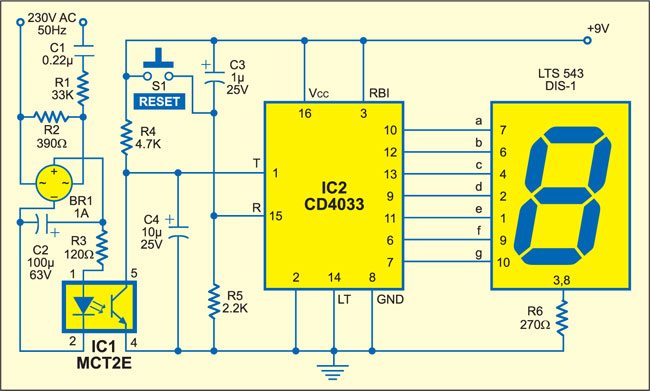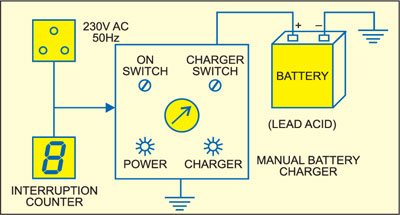 This mains interruption counter circuit counts mains supply interruptions (up to 9) and shows the number on a 7-segment display. It is highly useful for automobile battery chargers. Based on the number of mains interruptions, the user can extend the charging time for lead-acid batteries.
This mains interruption counter circuit counts mains supply interruptions (up to 9) and shows the number on a 7-segment display. It is highly useful for automobile battery chargers. Based on the number of mains interruptions, the user can extend the charging time for lead-acid batteries.
Mains interruption counter circuit

Fig. 1 shows the circuit of the interruption counter with indicator. A 9V (PP3 or 6F22) battery powers the entire circuit. Fig. 2 shows the block diagram of the mains interruption counter circuit along with the battery charger and lead-acid battery as used in automobile battery charger shops.
When 9V is applied to the circuit, IC2 is reset by the power-on-reset signal provided by capacitor C3 and resistor R5 and the 7-segment display (DIS1) shows ‘0.’ The 230V AC mains is fed to mains-voltage detection optocoupler IC MCT2E (IC1) via capacitor C1 and resistors R1 and R2 followed by bridge rectifier BR1, smoothing capacitor C2 and current-limiting resistor R2. Illumination of the LED inside optocoupler IC1 activates its internal phototransistor and clock input pin 1 of IC2 is pulled down to low level.

IC CD4033 (IC2) is a decade counter/7-segment decoder. Its pin 3 is held high so that the display initially shows ‘0.’ Clock pulses are applied to clock input pin 1 and clock-enable pin 2 is held low to enable the counter.
Seven-segment, common-cathode display DIS1 (LTS543) indicates the mains interruption count. Capacitor C2 provides a small turn-on delay for the display.
Circuit operation
When mains fails for the first time, clock input pin 1 of IC2 again goes high and display DIS1 shows ‘1.’ When mains resumes, pin 1 of IC2 goes low and DIS1 continues to show ‘1.’ When mains fails for the second time, clock input pin 1 of IC2 goes high and display DIS1 shows ‘2.’ When mains resumes, pin 1 of IC2 again goes low and DIS1 continues to show ‘2.’ This way, the counter keeps incrementing by ‘1’ on every mains interruption. Note that this circuit can count up to nine mains interruptions only.
The article was first published in April 2005 and has recently been updated.







are there proteus file